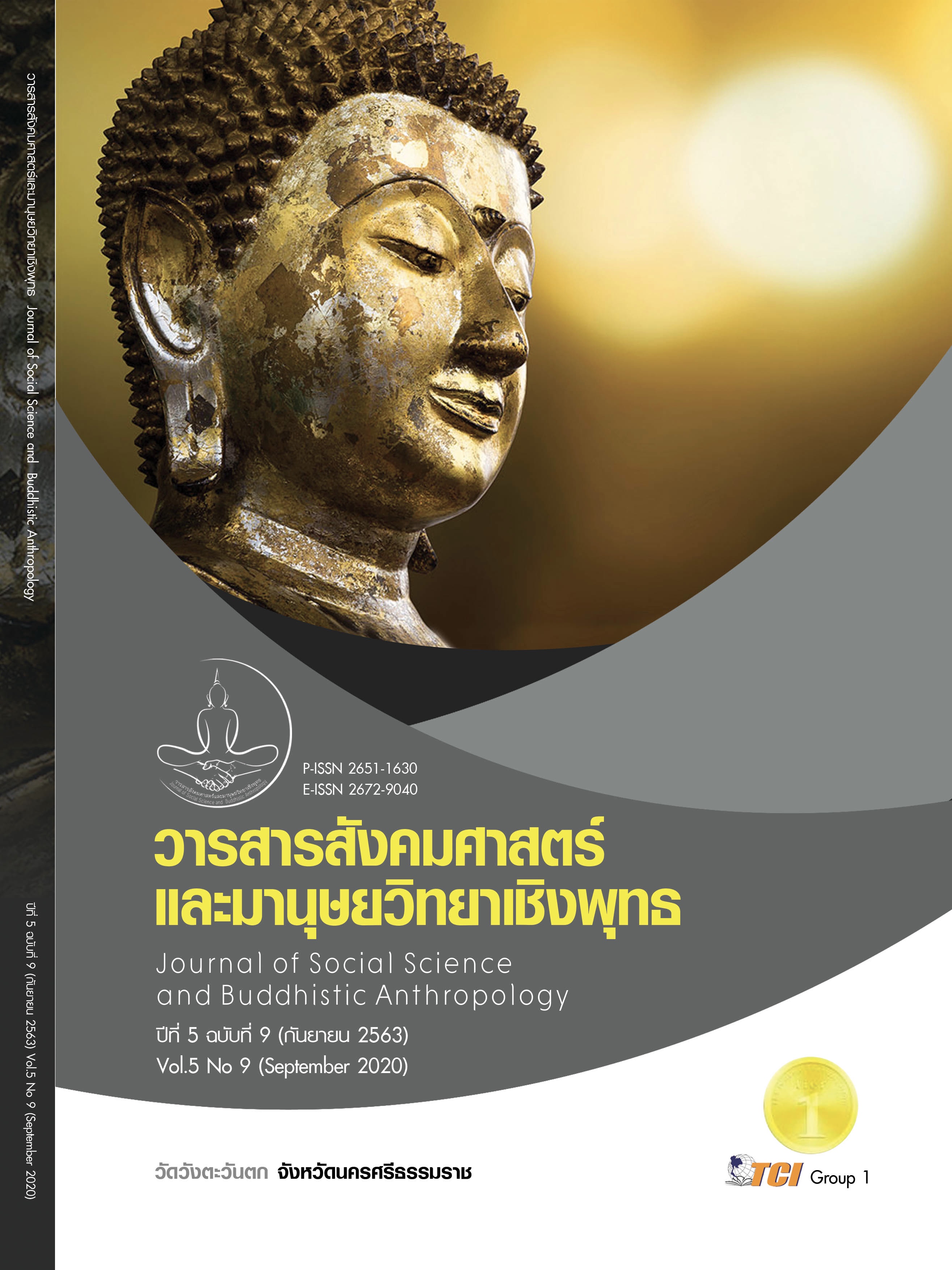MANAGEMENT MODEL OF THE BUDDHIST UNIVERSITY AFFECTING HAPPY WORKPLACE
Keywords:
Management Model, Buddhist Management, Happy workplace, The Buddhist UniversityAbstract
This article has a purpose 1) To study the management factors of the Buddhist university affecting happy workplace. 2) To study the relationship between the happiness of work personnel Buddhist administration and the happy workplace. And 3) to develop The efficient Management of the Buddhist university affecting happy workplace. Designed by a mixed method research. The sample group 310 persons in the research consisted of the Buddhist university personnel. Research tools include:1) In-depth interview 2) questionnaires. Data collection by using 1) Contact to send information by yourself 2) online questionnaire. The statistics used for data analysis. 1) Qualitative data was used content analysis methods 2) Quantitative data, were used lecture statistics. Include frequency, percentage, mean, standard deviation and analysis to check the validity of the model with transmitted variables and the analysis of direct and indirect influence sizes with SEM statistics. The findings conclude that: 1) The variables that are the components of the management of the Buddhist university affecting happy workplace are divided into 3 components: 1.1) the happiness of work personnel are 5 variables. 1.2) The Buddhist management has 4 variables. 1.3) The happy workplace has 4 variables, including all observable 13 variables. 2) The relationship between passive variable groups in the model found that: The variable with the highest relationship is happiness of work personnel and happy workplace with the relationship size of .825 related significantly at .01 level 3. The analysis results of the model developed by the researcher are suitable in harmony with empirical data. With the harmony index that passed the acceptance criteria is Chi-Square = 49.80, df = 37, P = 0.077, GFI = 0.97, AGFI 0.94, and RMSEA = 0.03
References
กรมสุขภาพจิต กระทรวงสาธารณสุข. (2552). รายงานประจำปี กรมสุขภาพจิต ปี 2552. เรียกใช้เมื่อ 13 มิถุนายน 2561 จาก https://www.dmh.go.th/ebook/view.asp?id=223
ขวัญเมือง บวรอัศวกุล. (2561). การเสริมสร้างคุณภาพชีวิตกับการทำงานอย่างมีความสุข. เรียกใช้เมื่อ 5 เมษายน 2561 จาก https://goo.gl/GcMg72
พระธรรมปิฎก (ป.อ.ปยุตฺโต). (2552). ความสุข 5 ชั้น. เรียกใช้เมื่อ 23 พฤษภาคม 2561 จาก http://www.cdthamma.com/forums/index.php?topic=2808.0
พระมหากิจการ โชติปญฺโญ. (2558). การบริหารงานบุคคลตามหลักธรรมทางพระพุทธศาสนา. วารสารบัณฑิตศาส์น มมร., 13(2), 48-5.
ยงยุทธ วงศ์ภิรมย์ศานติ์. (2555). การพัฒนาจิตตปัญญาในองค์กร การปรับกระบวนทัศน์และวัฒนธรรมองค์กร. (พิมพ์ครั้งที่ 2). กรุงเทพมหานคร: สำนักงานกองทุนสนับสนุนการสร้างเสริมสุขภาพ (สสส.).
ราชบัณฑิตยสถาน. (2542). พจนานุกรมไทยฉบับราชบัณฑิตยสถาน. เรียกใช้เมื่อ 27 พฤษภาคม 2561 จาก http://rirs3.royin.go.th
สมคิด ปิ่นทอง. (2556). รูปแบบการจัดการการกีฬาแห่งประเทศไทยให้เป็นองค์กรแห่งความสุข. ใน ดุษฎีนิพนธ์ปรัชญาดุษฎีบัณฑิต สาขาวิทยาศาสตร์การกีฬ. มหาวิทยาลัยเกษตรศาสตร์.
สิรินทร แซ่ฉั่ว. (2553). ความสุขในการทำงานของบุคลากรเชิงสร้างสรรค์กรณีศึกษาอุตสาหกรรมเชิง สร้างสรรค์กลุ่มสื่อและกลุ่มงานสร้างสรรค์เพื่อการใช้งาน. ใน วิทยานิพนธ์วิทยาศาสตรมหาบัณฑิต สาขาการพัฒนาทรัพยากรมนุษย์และองค์การ. สถาบันบัณฑิตพัฒนบริหารศาสตร์.
อรุณวดี คุ้มสิริพิทักษ์. (2545). การเสริมสร้างอำนาจในงานกับความพึงพอใจในงาน ของพนักงานในโรงงานอุตสาหกรรม. ใน วิทยานิพนธ์วิทยาศาสตรมหาบัณฑิต สาขาวิชาจิตวิทยาอุตสาหกรรมบัณฑิต. มหาวิทยาลัยเกษตรศาสตร์.
อาทิตยา จุฬาเสรีกุล และพระครูธีรวสาร. (2559). การใช้หลักอิทธิบาท 4 ในการบริหารการศึกษาวิทยาลัยศาสนศาสตร์เฉลิมพระเกียรติกาฬสินธุ์ มหาวิทยาลัยมหามกุฏราชวิทยาลัย. วารสารธรรมทรรศน์, 16(1), 41-51.
Burton, J. (2010). WHO Healthy Workplace Framework and Model. Retrieved November 29, 2018, from https://www.who.int/occupational_health/healthy_workplace_framework.pdf
Hair, J.F.J. et al. (1998). Multivariate Data Analysis. (5th ed). New Jersey: Prentice Hall.
Hosie, P. & Sevastos, P. (2009). Does the “happy‐productive worker” thesis apply to managers? International Journal of Workplace Health Management, 2(2), 131-160.
Lucas, R. E. et al. (2003). Measuring positive emotions. In S. J. Lopez & C. R. Snyder (Eds.), Positive psychological assessment: A handbook of models and measures. Washington, D.C., U.S.: American Psychological Association.
Lyubomirsky, S. et al. (2005). The Benefits of Frequent Positive Affect: Does Happiness Lead to Success? Psychological Bulletin, 131(6), 803-855.








